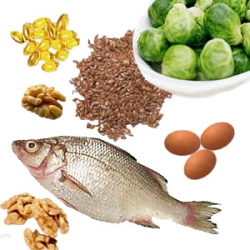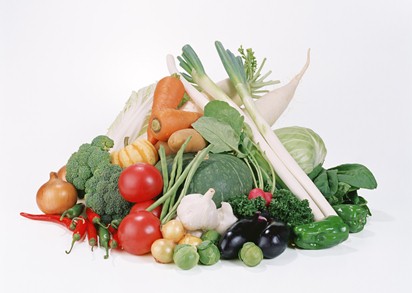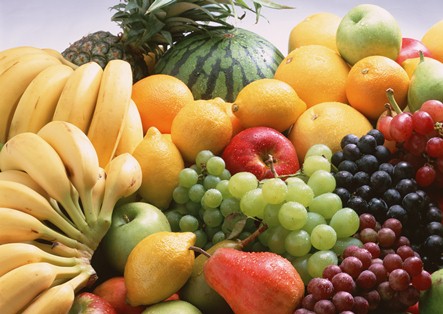
A nutrient is a chemical that an organism needs to live and grow or a substance used in an organism's metabolism which must be taken in from its environment.
Nutrients are the substances that enrich the body. They build and repair tissues, give heat and energy, and regulate body processes. Methods for nutrient intake vary, with animals and protists consuming foods that are digested by an internal digestive system, but most plants ingest nutrients directly from the soil through their roots or from the atmosphere. Some plants, like carnivorous plants, externally digest nutrients from animals, before ingesting them. The effects of nutrients are dose-dependent.

There are seven major classes of nutrients: carbohydrates, fiber, fats, minerals, protein, vitamins, and water. Organic nutrients include carbohydrates, fats, proteins (or their building blocks, amino acids), and vitamins. Inorganic chemical compounds such as dietary minerals, water, and oxygen may also be considered nutrients. A nutrient is essential to an organism if it cannot be synthesized by the organism in sufficient quantities and must be obtained from an external source. Nutrients needed in large quantities are called macronutrients; micronutrients are required in only small quantities.
Nutrients are frequently categorized as essential or nonessential. Essential nutrients are unable to be synthesized internally (either at all, or in sufficient quantities), and so must be consumed by an organism from its environment.
For humans, these include essential fatty acids, essential amino acids, vitamins, and certain dietary minerals. Oxygen and water are also essential for human survival, but are generally not considered "food" when consumed in isolation.
Humans can derive energy from a wide variety of fats, carbohydrates, proteins, and ethanol, and can synthesize other needed amino acids from the essential nutrients.
Non-essential substances within foods can still have a significant impact on health, whether beneficial or toxic. For example, most dietary fiber is not absorbed by the human digestive tract, but is important in digestion and absorption of otherwise harmful substances. Interest has recently increased in phytochemicals, which include many non-essential substances which may have health benefits.
An essential nutrient is a nutrient required for normal body functioning that either cannot be synthesized by the body at all, or cannot be synthesized in amounts adequate for good health (e.g. niacin, choline), and thus must be obtained from a dietary source. Essential nutrients are also defined by the collective physiological evidence for their importance in the diet, as represented in e.g. US government approved tables for Dietary Reference Intake.
Some categories of essential nutrients include vitamins, dietary minerals, essential fatty acids, and essential amino acids. Water and oxygen are also essential for human health and life, as oxygen cannot be synthesized by the body, and water, while a biochemical reaction product of metabolism, is not created in sufficient amounts. Both are necessary as biochemical reactants in some processes, and water is used in various ways such as a solvent, carrier, coolant, and integral polar structural member, but both are often not included as nutrients.
Different species have very different essential nutrients. For example, most mammals synthesize their own ascorbic acid, and it is therefore not considered an essential nutrient for such species. It is, however, an essential nutrient for human beings, who require external sources of ascorbic acid (known as Vitamin C in the context of nutrition).
Many essential nutrients are toxic in large doses. Some can be taken in amounts larger than required in a typical diet, with no apparent ill effects. Linus Pauling said of vitamin B3, (either niacin or niacinamide), "What astonished me was the very low toxicity of a substance that has such very great physiological power. A little pinch, 5 mg, every day, is enough to keep a person from dying of pellagra, but it is so lacking in toxicity that ten thousand times as much can (sometimes) be taken without harm
Carbohydrates
Toasted bread is a cheap, high calorie nutrient (usually unbalanced, i.e., deficient in essential minerals and vitamins, largely because of removal of both germ and bran during processing) food source.
Carbohydrates may be classified as monosaccharides, disaccharides, or polysaccharides depending on the number of monomer (sugar) units they contain. They constitute a large part of foods such as rice, noodles, bread, and other grain-based products. Monosaccharides, disaccharides, and polysaccharides contain one, two, and three or more sugar units, respectively. Polysaccharides are often referred to as complex carbohydrates because they are typically long, multiple branched chains of sugar units. The difference is that complex carbohydrates take slightly longer to digest and absorb because their sugar units must be separated from the chain before absorption. The spike in blood glucose levels after ingestion of simple sugars is thought to be related to some of the heart and vascular diseases that have become more frequent in recent times. Simple sugars form a greater part of modern diets than formerly, perhaps leading to more cardiovascular disease. The degree of causation is still not clear, however.
units they contain. They constitute a large part of foods such as rice, noodles, bread, and other grain-based products. Monosaccharides, disaccharides, and polysaccharides contain one, two, and three or more sugar units, respectively. Polysaccharides are often referred to as complex carbohydrates because they are typically long, multiple branched chains of sugar units. The difference is that complex carbohydrates take slightly longer to digest and absorb because their sugar units must be separated from the chain before absorption. The spike in blood glucose levels after ingestion of simple sugars is thought to be related to some of the heart and vascular diseases that have become more frequent in recent times. Simple sugars form a greater part of modern diets than formerly, perhaps leading to more cardiovascular disease. The degree of causation is still not clear, however.
Simple carbohydrates are absorbed quickly, and therefore raise blood-sugar levels more rapidly than other nutrients. However, the most important plant carbohydrate nutrient, starch, varies in its absorption. Gelatinized starch (starch heated for a few minutes in the presence of water) is far more digestible than plain starch. In addition, starch that has been divided into fine particles is also absorbed more readily during digestion. The increased effort and decreased availability reduces the available energy from starchy foods substantially and can be seen experimentally in rats[citation needed] and anecdotally in humans. Additionally, up to a third of dietary starch may be unavailable due to mechanical or chemical difficulty.
Carbohydrates are not essential to the human diet, as they are relatively low in vitamins and minerals, and energy can be provided from excess fats and proteins in the diet.
Fiber
The parts of plants that cannot be digested, namely complex carbohydrates. Also known as bulk or roughage.
Complex carbohydrates from plants are rich in starch and fiber. Examples of plants that provide complex carbohydrates (fiber) are fresh fruits and vegetables, whole-grain breads, and cereal grains. Simple carbohydrates, such as common table sugar, have no fiber.
Dietary fiber can have many benefits including promoting bowel regularity, lowering the level of cholesterol in the blood, and easing conditions such as hemorrhoids, colitis, and diverticulosis. Dietary fiber can also aid in weight maintenance as it requires more chewing and promotes hunger satisfaction by giving the stomach a sense of fullness.
Fat
A molecule of dietary fat typically consists of several fatty acids (containing long chains of carbon and hydrogen atoms), bonded to a glycerol. They are typically found as triglycerides (three fatty acids attached to one glycerol backbone). Fats may be classified as saturated
or unsaturated depending on the detailed structure of the fatty acids involved. Saturated fats have all of the carbon atoms in their fatty acid chains bonded to hydrogen atoms, whereas unsaturated fats have some of these carbon atoms double-bonded, so their molecules have relatively fewer hydrogen atoms than a saturated fatty acid of the same length. Unsaturated fats may be further classified as monounsaturated (one double-bond) or polyunsaturated (many double-bonds). Furthermore, depending on the location of the double-bond in the fatty acid chain, unsaturated fatty acids are classified as omega-3 or omega-6 fatty acids. Trans fats are a type of unsaturated fat with trans-isomer bonds; these are rare in nature and in foods from natural sources; they are typically created in an industrial process called (partial) hydrogenation. There are nine kilocalories in each gram of fat.[citation needed]
Saturated fats (typically from animal sources) have been a staple in many world cultures for millennia. Unsaturated fats (e. g., vegetable oil) are considered healthier, while trans fats are to be avoided. Saturated and some trans fats are typically solid at room temperature (such as butter or lard), while unsaturated fats are typically liquids (such as olive oil or flaxseed oil). Trans fats are very rare in nature, and have been shown to be highly detrimental to human health, but have properties useful in the food processing industry, such as rancidity resistance.
Essential fatty acids
Essential fatty acids, or EFAs, are fatty acids that humans and other animals must ingest for good health because the body requires them
but can't make them from other food components. The term refers to fatty acids required for biological processes, and not those that only act as fuel.
There are only two EFAs: alpha-linolenic acid, an omega-3 fatty acid, and linoleic acid, an omega-6 fatty acid. Some researchers consider gamma-linolenic acid (omega-6), lauric acid (saturated fatty acid), and palmitoleic acid (monosaturated fatty acid) conditionally essential.
Iodolipids
Iodolipids are iodinated lipids which have important actions in biochemistry and physiology of all living cells. Iodine can add to double bonds of docosahexaenoic acid and arachidonic acid, making them less reactive to free oxygen radicals. Multiple iodolipid classes comprising iodolactones and iodoaldehydes (α-iodohexadecanal) have been identified that have structural and metabolic functions in plant, animal and human cells. Arachidonic acid and iodolactones specifically inhibit signal transduction pathways induced by local growth factors such as epidermal growth factor and basic fibroblast growth factor Delta-iodolactones, at physiological concentrations, have antiproliferative effects and could be intermediates in iodine-induced autoregulation of cell proliferation, especially of the thyroid gland and mammary gland.
Protein
Proteins are the basis of many animal body structures (e.g. muscles, skin, and hair). They also form the enzymes that control chemical reactions throughout the body. Each molecule is composed of amino acids, which are characterized by inclusion of nitrogen and sometimes sulphur (these components are responsible for the distinctive smell of burning protein, such as the keratin in hair). The body requires amino acids to produce new proteins (protein retention) and to replace damaged proteins (maintenance). As there is no protein or amino acid storage provision, amino acids must be present in the diet. Excess amino acids are discarded, typically in the urine. For all animals, some amino acids are essential (an animal cannot produce them internally) and some are non-essential (the animal can produce them from other nitrogen-containing compounds). About twenty amino acids are found in the human body, and about ten of these are essential and, therefore, must be included in the diet. A diet that contains adequate amounts of amino acids (especially those that are essential) is particularly important in some situations: during early development and maturation, pregnancy, lactation, or injury (a burn, for instance). A complete protein source contains all the essential amino acids; an incomplete protein source lacks one or more of the essential amino acids.
reactions throughout the body. Each molecule is composed of amino acids, which are characterized by inclusion of nitrogen and sometimes sulphur (these components are responsible for the distinctive smell of burning protein, such as the keratin in hair). The body requires amino acids to produce new proteins (protein retention) and to replace damaged proteins (maintenance). As there is no protein or amino acid storage provision, amino acids must be present in the diet. Excess amino acids are discarded, typically in the urine. For all animals, some amino acids are essential (an animal cannot produce them internally) and some are non-essential (the animal can produce them from other nitrogen-containing compounds). About twenty amino acids are found in the human body, and about ten of these are essential and, therefore, must be included in the diet. A diet that contains adequate amounts of amino acids (especially those that are essential) is particularly important in some situations: during early development and maturation, pregnancy, lactation, or injury (a burn, for instance). A complete protein source contains all the essential amino acids; an incomplete protein source lacks one or more of the essential amino acids.
It is possible to combine two incomplete protein sources (e.g. rice and beans) to make a complete protein source, and characteristic combinations are the basis of distinct cultural cooking traditions.[citation needed] Sources of dietary protein include meats, tofu and other soy-products, eggs, legumes, and dairy products such as milk and cheese. Excess amino acids from protein can be converted into glucose and used for fuel through a process called gluconeogenesis. The amino acids remaining after such conversion are discarded.
Minerals
Dietary minerals are the chemical elements required by living organisms, other than the four elements carbon, hydrogen, nitrogen, and oxygen that are present in nearly all organic molecules. The term "mineral" is archaic, since the intent is to describe simply the less common elements in the diet. Some are heavier than the four just mentioned, including several metals, which often occur as ions in the body. Some dietitians recommend that these be supplied from foods in which they occur naturally, or at least as complex compounds, or sometimes even from natural inorganic sources (such as calcium carbonate from ground oyster shells). Some minerals are absorbed much more readily in the ionic forms found in such sources. On the other hand, minerals are often artificially added to the diet as supplements; the most famous is likely iodine in iodized salt which prevents goiter.
Macrominerals
Many elements are essential in relative quantity; they are usually called "bulk minerals". Some are structural, but many play a role as electrolytes. Elements with recommended dietary allowance (RDA) greater than 200 mg/day are, in alphabetical order (with informal or folk-medicine perspectives in parentheses):
- Calcium, a common electrolyte, but also needed structurally (for muscle and digestive system health, bone strength, some forms neutralize acidity, may help clear toxins, provides signaling ions for nerve and membrane functions).
- Chlorine as chloride ions; very common electrolyte; see sodium, below
- Magnesium, required for processing ATP and related reactions (builds bone, causes strong peristalsis, increases flexibility, increases alkalinity)
- Phosphorus, required component of bones; essential for energy processing
- Potassium, a very common electrolyte (heart and nerve health)
- Sodium, a very common electrolyte; not generally found in dietary supplements, despite being needed in large quantities, because the ion is very common in food: typically as sodium chloride, or common salt. Excessive sodium consumption can deplete calcium[citation needed] and magnesium, leading to high blood pressure and osteoporosis.
- Sulfur, for three essential amino acids and therefore many proteins (skin, hair, nails, liver, and pancreas). Sulfur is not consumed alone, but in the form of sulfur-containing amino acids
Trace minerals
Many elements are required in trace amounts, usually because they play a catalytic role in enzymes. Some trace mineral elements (RDA < 200 mg/day) are, in alphabetical order:
- Cobalt required for biosynthesis of vitamin B12 family of coenzymes. Animals cannot biosynthesize B12, and must obtain this cobalt-containing vitamin in the diet
- Copper required component of many redox enzymes, including cytochrome c oxidase
- Chromium required for sugar metabolism
Iodine required not only for the biosynthesis of thyroxine, but probably, for other important organs as breast, stomach, salivary glands, thymus etc. (see Extrathyroidal iodine); for this reason iodine is needed in larger quantities than others in this list, and sometimes classified with the macrominerals
- Iron required for many enzymes, and for hemoglobin and some other proteins
- Manganese (processing of oxygen)
- Molybdenum required for xanthine oxidase and related oxidases
- Nickel present in urease
- Selenium required for peroxidase (antioxidant proteins)
- Vanadium (Speculative: there is no established RDA for vanadium. No specific biochemical function has been identified for it in humans, although vanadium is required for some lower organisms.
- Zinc required for several enzymes such as carboxypeptidase, liver alcohol dehydrogenase, and carbonic anhydrase
Vitamins
As with the minerals discussed above, some vitamins are recognized as essential nutrients, necessary in the diet for good health. (Vitamin D is the exception: it can be synthesized in the skin, in the presence of UVB radiation.) Certain vitamin-like compounds that are recommended in the diet, such as carnitine, are thought useful for survival and health, but these are not "essential" dietary nutrients because the human body has some capacity to produce them from other compounds. Moreover, thousands of different phytochemicals have recently been discovered in food (particularly in fresh vegetables), which may have desirable properties including antioxidant activity ; however, experimental demonstration has been suggestive but inconclusive. Other essential nutrients that are not classified as vitamins include essential amino acids, choline, essential fatty acids, and the minerals discussed in the preceding section.
D is the exception: it can be synthesized in the skin, in the presence of UVB radiation.) Certain vitamin-like compounds that are recommended in the diet, such as carnitine, are thought useful for survival and health, but these are not "essential" dietary nutrients because the human body has some capacity to produce them from other compounds. Moreover, thousands of different phytochemicals have recently been discovered in food (particularly in fresh vegetables), which may have desirable properties including antioxidant activity ; however, experimental demonstration has been suggestive but inconclusive. Other essential nutrients that are not classified as vitamins include essential amino acids, choline, essential fatty acids, and the minerals discussed in the preceding section.
Vitamin A ensures that the skin and hair are healthy. It also helps to maintain a state of resistance to infection of the eyes, respiratory tract and digestive system. It is required for good eyesight. Food sources of vitamin A are fish liver oil, butter, cream, and dark green and dark yellow vegetables.
Vitamin D is known as the sunshine vitamin and works to help the body to better use calcium and phosphorus. It can be obtained from such food sources as fish liver oils and milk enriched with vitamin D.
Vitamin E has significant functions in relation to human metabolism. It speeds up healing. It can be obtained from foods such as vegetables oils, milk, eggs, meats, cereals, and leafy vegetables.
Vitamin K is essential for clotting of the blood, should a person become wounded or the blood's viscosity very thin. It is found in green, leafy vegetables, liver, soybean, and vegetable oils.
Thiamin maintains healthy nerves and is needed for the metabolism of carbohydrates. It is found in fruits, vegetables, whole grain, and enriched cereal products.
Riboflavin helps keep the skin, mouth and eyes healthy, and helps to maintain resistance to infection. Food sources of riboflavin are milk, meat, whole grain, enriched grain products, fruits, and vegetables.
Niacin increases resistance to infection and prevents pellagra. Sources of niacin include milk, meat, dark green and deep yellow vegetables, whole grain and enriched grain products.
Ascorbic acid, or vitamin C as it is more often called, increases resistance to infections and also keeps teeth and gums in good condition. It can be found in citrus fruits, green and yellow vegetables, milk, and meat.
Insufficient consumption of vitamins may cause severe deficiencies. Deficiencies of niacin can cause pellagra, an illness characterized by diarrhea, dementia, and dermatitis. Lack of vitamin A can result in kerophthalmia, an eye disease that can result in blindness. Deficiency of thiamin results in beri-beri, or numbness of the feet, legs, arms and muscles, as well as degeneration. Lack of vitamin C will result in scurvy, characterized by loss of weight, sore, bleeding and swollen gums and loss of teeth. Lack of vitamin D causes an illness called ostemalacia, or softening of the bones in the wrists and ankles. Another consequence of insufficient vitamin D is rickets, or bow-leggedness, and knocked knees.
Other nutrients
Other micronutrients include antioxidants and phytochemicals. These substances are generally more recent discoveries that have not yet been recognized as vitamins or as required. Phytochemicals may act as antioxidants, but not all phytochemicals are antioxidants.
Antioxidants
As cellular metabolism/energy production requires oxygen, potentially damaging (e.g. mutation causing) compounds known as free radicals can form. Most of these are oxidizers (i.e. acceptors of electrons) and some react very strongly. For the continued normal cellular
maintenance, growth, and division, these free radicals must be sufficiently neutralized by antioxidant compounds. Recently, some researchers suggested an interesting theory of evolution of dietary antioxidants. Some are produced by the human body with adequate precursors (glutathione, Vitamin C), and those the body cannot produce may only be obtained in the diet via direct sources (Vitamin C in humans, Vitamin A, Vitamin K) or produced by the body from other compounds (Beta-carotene converted to Vitamin A by the body,[citation needed] Vitamin D synthesized from cholesterol by sunlight). Phytochemicals (Section Below) and their subgroup, polyphenols, make up the majority of antioxidants; about 4,000 are known. Different antioxidants are now known to function in a cooperative network. For example, Vitamin C can reactivate free radical-containing glutathione or Vitamin E by accepting the free radical itself.[citation needed] Some antioxidants are more effective than others at neutralizing different free radicals. Some cannot neutralize certain free radicals. Some cannot be present in certain areas of free radical development (Vitamin A is fat-soluble and protects fat areas, Vitamin C is water soluble and protects those areas). When interacting with a free radical, some antioxidants produce a different free radical compound that is less dangerous or more dangerous than the previous compound. Having a variety of antioxidants allows any byproducts to be safely dealt with by more efficient antioxidants in neutralizing a free radical's butterfly effect.
Although initial studies suggested that antioxidant supplements might promote health, later large clinical trials did not detect any benefit and suggested instead that excess supplementation may be harmful.
Phytochemicals
Phytochemicals are chemical compounds such as beta-carotene that occur naturally in plants. The term is generally used to refer to those chemicals that may affect health, but are not yet established as essential nutrients. While there is abundant scientific and government support for recommending diets rich in fruits and vegetables, there is only limited evidence that health benefits are due to specific phytochemicals.
chemicals that may affect health, but are not yet established as essential nutrients. While there is abundant scientific and government support for recommending diets rich in fruits and vegetables, there is only limited evidence that health benefits are due to specific phytochemicals.
Phytochemicals have been used as drugs for millennia. For example, Hippocrates may have prescribed willow tree leaves to abate fever. Salicin, having anti-inflammatory and pain-relieving properties, was originally extracted from the bark of the white willow tree and later synthetically produced became the staple over-the-counter drug called Aspirin. There is evidence from laboratory studies that phytochemicals in fruits and vegetables may reduce the risk of cancer, possibly due to dietary fibers, polyphenol antioxidants and anti-inflammatory effects. Specific phytochemicals, such as fermentable dietary fibers, are allowed limited health claims by the US Food and Drug Administration (FDA).
An important cancer drug, Taxol (paclitaxel), is a phytochemical initially extracted and purified from the Pacific yew tree.
Among phytochemicals from edible plants with promise for deterring disease, diindolylmethane, from Brassica vegetables (broccoli, cauliflower, cabbage, kale, Brussels sprouts) is being tested against recurring respiratory papillomatosis tumors (caused by the human papilloma virus), is in Phase III clinical trials for cervical dysplasia (a precancerous condition caused by the human papilloma virus) and is in several clinical trials for prostate cancer.
Some phytochemicals with physiological properties may be elements rather than complex organic molecules. Abundant in many fruits and vegetables, selenium, for example, is involved with major metabolic pathways, including thyroid hormone metabolism and immune function. Particularly, it is an essential nutrient and cofactor for the enzymatic synthesis of glutathione, an endogenous antioxidant.
![]()
Disclaimer: This website is for information purposes only. By providing the information contained herein we are not diagnosing, treating, curing, mitigating, or preventing any type of disease or medical condition. Before beginning any type of natural, integrative or conventional treatment regime, it is advisible to seek the advice of a licensed healthcare professional.



























